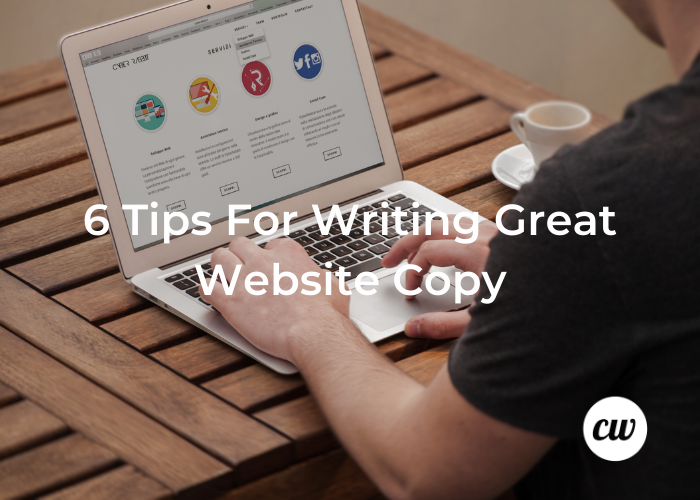
6 Tips For Writing Great Website Copy
The best website copy is powerful. It captures the reader’s attention from the very beginning, taking them on a journey through a brand and its unique selling proposition. However, achieving such a high caliber of copywriting for the web is not an easy feat. It takes discipline as well as a keen understanding of your unique audience. Today, we’ll dive into six actionable tips to help you write great website copy.
Web Copywriting: The Basics
What is website copy?
Website copy typically refers to text that appears on a brand’s site, including headlines, descriptions, calls-to-action, and other written content. It is the primary way that entities communicate with their audience, making it an essential part of any successful site.
While we’ll discuss more about what makes great website copy, the bottom line should include engaging, informative, and persuasive content. Your web copywriting should provide visitors with a clear understanding of what your brand offers and how it can benefit them.
Tip 1: Research Your Market
Research is the foundation of great website copywriting; it’s essential to understand your market. Without research, it can become difficult to navigate your market & create copy that resonates with your target users. It’s like shooting in the dark.
By conducting thorough research, however, you can effectively turn the light on and help guide your copywriting efforts. You’ll be able to identify which tone & voice to use and further chisel the perfect messaging & language to deploy your copy.
Research can also help you identify the right keywords to use in your copy, thereby improving your search engine optimization (SEO) & the website’s visibility. Great research leads to great copywriting!
What does solid research look like?
Well, there’s no one size fits all solution. The best research will adapt to your brand, business model, and unique selling avenue. As a general rule, though, it should dive into an intersection of product, competition, and audience. You want to deeply understand which features must be capitalized in your copywriting and further how competitors are marketing to your audience — or similar ones.
Here are some ways to help you get started researching your market.
- Define your ideal consumer profile (ICP)
This is a potent first step in understanding your target niche better. It’s the process of defining with high specificity what your perfect customer looks like. How old are they? What do they earn? Where do they spend their digital time? Asking and answering such questions will help align your web copy with the right audience. Without taking this first step, research and copywriting can end up aimless and without direction.
- Survey the market
There’s no better place to hear the truth than its source. So get it from there! User studies have proven to be invaluable for marketing research, with a promising reputation for shedding light on customers’ true needs — the ones they don’t know they have yet. Once those are clarified, copywriting toward them becomes much easier.
- Study what works
After carving out your ICP and investigating its nature, the final way to level up your web copy is to study the competition. There are always brands to learn from, especially when it comes to copywriting. Make a list of three to five companies who are either a) direct competitors or b) in adjacent markets; then examine their formula for success. How were their headlines structured? What kind of language did they choose? What about colors? These can be useful insights to apply to your own web copy.
Tip 2: Do More With Less
The next tip for great web copy is to focus on writing shorter, more concise content for your site.
A study by TIME magazine discovered that the average human being has about 8 seconds of attention to dedicate before losing interest. That means your website and its copywriting have quite a short window of time to grab a visitor’s attention. Do you think long paragraphs will get the job done? While possible, it’s doubtful.
There are countless iconic examples in digital marketing history where brands have committed to this tenet of doing more with less:
- Apple’s “Think Different”
- Nike’s “Just Do It”
- Walmart’s “Save Money, Live Better”
These companies get across a more impactful message by using fewer words. It’s the fact that those words are chosen so carefully that they’re able to convey exactly what is sought after and capture users. Aim to highlight more of your brand, ethos, and unique selling proposition (USP) through punchy web copy.
How do you write website copy?
To write website copy, focus on writing content that engages, informs, and persuades your audience. Highlight your brand and why people should care about it.
Remember that website copy is an essential part of communicating with your audience and must provide visitors with a clear understanding of what your brand offers and how it can benefit them.
Tip 3: Sell Feelings, Not Features
Our next tip for writing outstanding website copy addresses the nature of your content itself rather than its structure. When marketing a brand, product, or service, selling feelings over features is highly effective.
What does this mean? Take, for instance, a recent McDonald’s campaign that read “Order Happiness.” It tells the reader, albeit quite simply, that this food will bring you joy. The feelings-over-features technique works by leveraging an element of pathos and using it to target your audience’s emotional interest. Once they buy into the feeling, you’ve sold them on the features.
Putting This To Work
First, identify your ideal user persona. Then ask: How would they like to feel?
If your product & brand aim to target a wealthier social demographic, your website copy needs to market the feeling of luxury. If your product is a bed, sell the feeling of comfort. The core idea here is to tie your product to a desirable feeling and then sell that in your copy. Showcase for your audience where you can take them.
How long should a website copy be?
There isn’t a set rule for how long a website copy should be. It’s more important to focus on writing informative, persuasive content that conveys your brand’s message clearly.
The general recommendation is to keep web copy concise and to the point since visitors typically have a short attention span. Aim to communicate more value with less and focus on selling to your audience.
Tip 4: Speak To Solutions
Solution selling is a very powerful technique in web copywriting. It is a way of framing your product or service as a solution to direct problems — pain points — that your audience may have. By doing so, you can better convey the value that you offer.
This approach is particularly important in the business world, where transactions are often driven by the exchange of value. When crafting your web copy, it helps to keep in mind that your audience is likely looking for a solution to a problem or set of problems they have. You can focus on communicating how your brand can solve those problems and highlight your product or service’s benefits.
This helps your audience better understand the value that you offer and why they should choose your brand over others. Where possible, you can use examples or case studies to demonstrate how your brand has helped other clients in the past and how it can do the same for your target audience.
Tip 5: Use Strong CTAs
When it comes to website copy, there is one tip that stands out above the rest: your Call To Action (CTA). Your CTA is the message that ends your user’s journey with a strong and directive statement. It is the final opportunity for you to convince your user to take action.
The metric success of your website — conversions, click-throughs, etc.— can largely depend on the quality of your CTA. A well-crafted CTA can make all the difference in whether a user clicks that “Buy Now” button or simply exits the site.
A good CTA is clear, concise, and persuasive. It offers value to the user and is relevant to the content on the page. One way to create a strong CTA is to use action-oriented language that inspires the user to take action. For example, instead of saying “Learn More,” use “Discover the Benefits” or “Unlock the Secrets.”
Another way to make your CTA more effective is to use urgency or scarcity. If there is a limited-time offer or a limited number of products available, make sure to mention it in your CTA. This can create a sense of urgency in the user and motivate them to take action before it’s too late.
Tip 6: Publish, Test, Iterate
Our final tip for writing great web copywriting leans into data as a source of insight. Essentially, you want to do more of what works. However, without defensible numbers, it can be hard to put your finger on exactly what that is. Was it these colors, those words, or something entirely different that led to your success? That’s where the publish, test, and iterate flywheel can help.
One way to collect data is through A/B testing. This technique involves creating two or more versions of a webpage or email, changing one element (such as the headline or button color), and tracking which version performs better. By comparing the results, you can gain insights into what resonates with your audience and adjust your copywriting accordingly.
Another way to gather data is through user surveys, as we mentioned earlier. You can ask your website visitors or email subscribers to provide feedback on the content you’ve created, including copywriting. This can provide valuable insights into what they find engaging or confusing about your messaging.
By incorporating data into your copywriting process, you can create content that resonates with your audience and drives results. The key is to continuously test, analyze, and iterate to ensure that your messaging is as effective as possible.
Wrapping Up
Website copywriting can seem like a daunting task, even for veteran wordsmiths. That’s why it’s helpful to keep these 6 helpful tips in mind while crafting your web copy. Don’t overlook the importance of great research & thoughtful wording. Aim to sell to your unique audience and address their pain points through concise & punchy copy. Finally, end with a powerful call to action and measure its success.
Animesh is a professional writer with expertise in business, tech and marketing.




